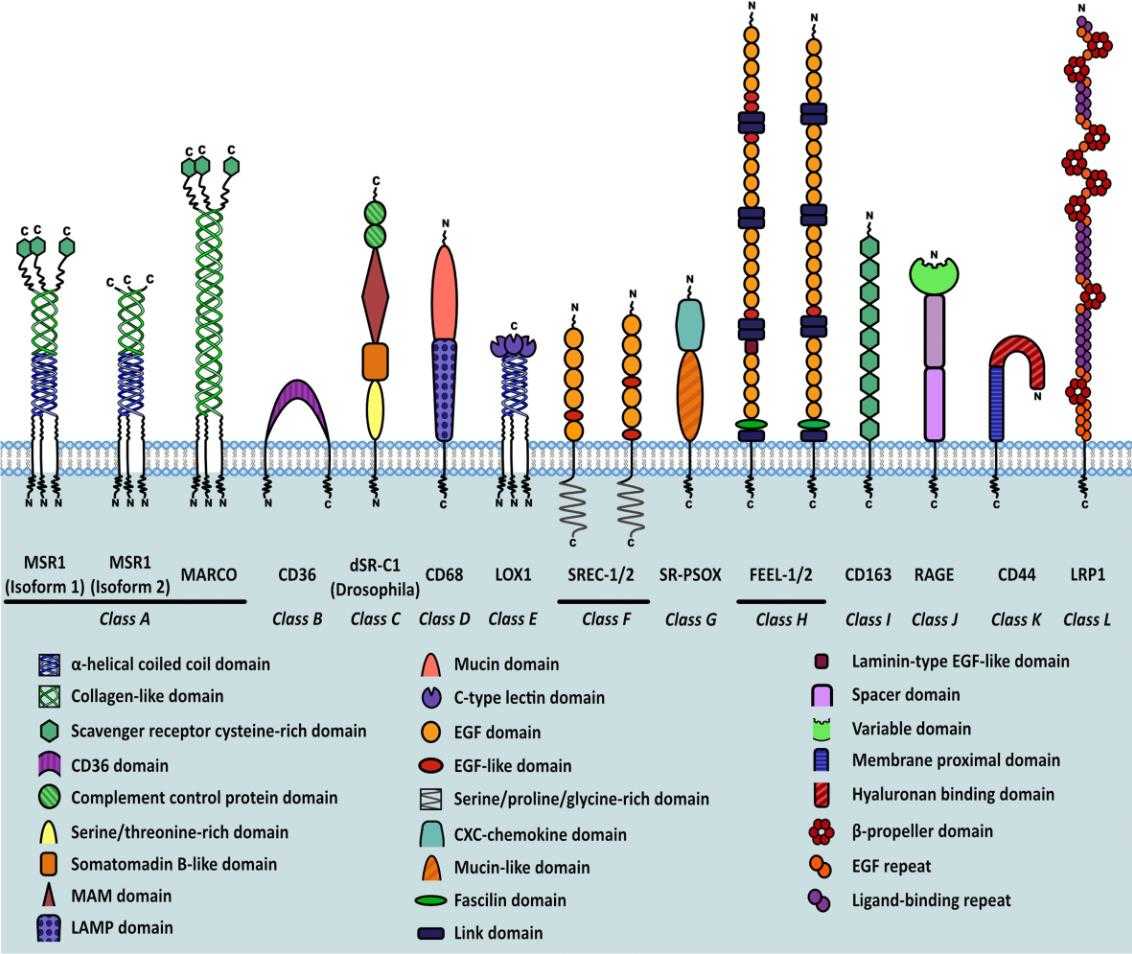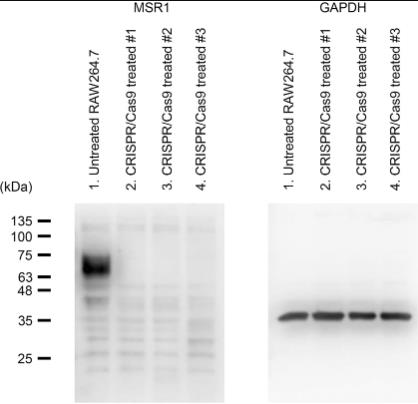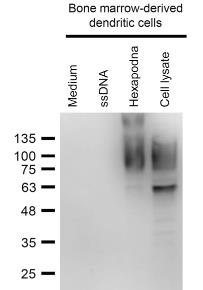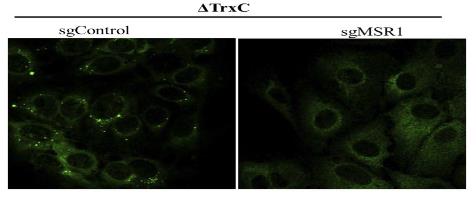Msr1
-
Official Full Name
macrophage scavenger receptor 1 -
Overview
This gene encodes the class A macrophage scavenger receptors, which include three different types (1, 2, 3) generated by alternative splicing of this gene. These receptors or isoforms are macrophage-specific trimeric integral membrane glycoproteins and have been implicated in many macrophage-associated physiological and pathological processes including atherosclerosis, Alzheimers disease, and host defense. The isoforms type 1 and type 2 are functional receptors and are able to mediate the endocytosis of modified low density lipoproteins (LDLs). The isoform type 3 does not internalize modified LDL (acetyl-LDL) despite having the domain shown to mediate this function in the types 1 and 2 isoforms. It has an altered intracellular processing and is trapped within the endoplasmic reticulum, making it unable to perform endocytosis. The isoform type 3 can inhibit the function of isoforms type 1 and type 2 when co-expressed, indicating a dominant negative effect and suggesting a mechanism for regulation of scavenger receptor activity in macrophages. -
Synonyms
MSR1;macrophage scavenger receptor 1;macrophage scavenger receptor types I and II;CD204;SCARA1;scavenger receptor class A member 1;scavenger receptor class A, member 1;macrophage scavenger receptor type III;macrophage acetylated LDL receptor I and;SRA;SR-A;phSR1;phSR2
Recombinant Proteins
- Human
- Mouse
- Rat
- Mus musculus
- Bovine
- HEK293
- E.coli
- Mammalian Cells
- Wheat Germ
- Human Cells
- Insect Cells
- His
- Non
- T7
- GST
- Fc
- DDK
- Myc
- Avi
Background

Fig1. Classification of scavenger receptors and MSR1 isoforms. (Jack Gudgeon, 2022)
What is MSR1 Protein?
MSR1, also known as macrophage scavenger receptor 1 or CD204, is a protein in humans that plays a significant role in the body's immune response. It's part of the class A scavenger receptor family, which includes several types produced through alternative splicing of the MSR1 gene. These receptors are primarily found on macrophages and are involved in various physiological and pathological processes like atherosclerosis, Alzheimer's disease, and immune defense mechanisms. There's an interesting twist, though: while Types 1 and 2 can effectively work to capture and process certain molecules like LDLs, Type 3 can't do this because it doesn't get properly processed inside cells, although it can interfere with the first two types. This inhibitory capability hints at a sort of internal regulation mechanism for these receptors. In the world of biotechnology, MSR1 has even been shown to help macrophages stick to different surfaces, an ability that researchers often exploit. Adding to its complexity, MSR1 can also interact with certain proteins like HSPA1A, expanding its potential impact on cellular functions.
What is the Function of MSR1 Protein?
The MSR1 protein, also known as macrophage scavenger receptor 1 or CD204, is a fascinating component within our bodies encoded by the MSR1 gene. This protein is mostly found in our immune cells, specifically macrophages, where it plays a significant role in gobbling up unwanted materials. It's got three main versions or isoforms created through alternative splicing. The first two types actively help in engulfing stuff like modified LDL, which is crucial because these lipoproteins, if left unchecked, can contribute to atherosclerosis. Interestingly, the third version can't perform this function; instead, it seems to regulate or downplay the activity of the other two, acting sort of like a 'brake' within the system. This protein doesn't just stick to macrophages; it's been spotted on some dendritic cells too. Beyond its foundational clean-up duties, MSR1 is linked with several other conditions, including Alzheimer's and various defense mechanisms.
MSR1 Related Signaling Pathway
The MSR1 protein, also known as macrophage scavenger receptor 1, is quite the multi-tasker. It's got these receptors that come in three types, thanks to some nifty gene splicing. Types 1 and 2 are real go-getters, helping macrophages to gobble up bad cholesterol (like LDL) and play roles in disease processes like atherosclerosis and Alzheimer's. It's not just about defense, though; they also help clear out amyloid-beta, which is pretty important for neuro stuff. Type 3, however, is the odd one out—it can't do the LDL thing because it gets stuck in the wrong cell compartment. This can throw a wrench in the works, sometimes inhibiting the other types.
MSR1 Related Diseases
MSR1, or macrophage scavenger receptor 1, is essentially a kind of protein hanging out on the outside of certain cells, like macrophages. It's pretty important since it acts like a garbage collector, grabbing onto all sorts of unwanted substances such as modified low-density lipoproteins (LDL) — think of these as bad cholesterol particles. This protein is involved in plenty of biological processes, playing roles in conditions like atherosclerosis — where arteries get clogged with these particles — and even Alzheimer's disease. It also jumps in during the body's defense operations against invading substances. The protein is a trim kick-ass trio known as class A scavenger receptors, which are also divided into three types based on genetic splicing.
Bioapplications of MSR1
Recombinant MSR1 protein has made quite a splash in research and industrial production areas. It's like a multi-tool in a scientist's toolkit. For starters, it's used in studying how our immune system deals with threats like atherosclerosis and Alzheimer's disease, since MSR1 is involved in macrophage-related processes. Researchers are exploring how this protein impacts cellular uptake and cholesterol regulation. In the industrial sector, MSR1's role in binding different substances makes it handy for developing assays or biosensors, especially in fields requiring detection of specific molecules or pathogens. All in all, recombinant MSR1 is a hot ticket for folks interested in both basic science and practical applications related to health and disease.
Case Study
Case Study 1: Keisuke Umemura, 2021
Even though macrophage-like RAW264.7 and other immune cells can efficiently take up polypod-like nanostructured DNA, known as polypodna, the exact mechanism remains a bit of a mystery. Our earlier work with HEK-Blue hTLR9 cells found that introducing macrophage scavenger receptor 1 (MSR1) helped boost the intake of DNA structured like tetrapods. In this study, we looked into how MSR1 might play a part in how polypodna is absorbed, depending on its structure. When MSR1 was added to HEK-Blue hTLR9 cells, it increased polypodna uptake based on the number of pods, while knocking it out in RAW264.7 cells led to reduced intake and less cytokine release. To see how DNA binds with MSR1, biotinylated DNA was introduced to RAW264.7 cells and was linked to cell surface proteins. We found that MSR1 interacted with polypodna but not with single-stranded DNA. This pattern was also seen in murine primary immune cells. So, it seems MSR1 differentiates between simple and complex nanostructured DNAs and is key to the immune cells' effective intake of polypodna.

Fig1. Western blotting analysis of MSR1 in CRISPR/Cas9-treated RAW264.7 cells.

Fig2. Western blotting analysis of MSR1 in the proteins cross-linked with biotinylated ssDNA and polypodna.
Case Study 2: Chunxiao Ji, 2024
The thioredoxin (Trx) system is all about keeping proteins in check against oxidative stress and making sure they bond right to perform well. In our past research, we found that TrxA from Streptococcus suis Serotype 2 (SS2) helps in virulence but doesn't really deal with oxidative stress. Now, we looked into another Trx family gene, TrxC. This one codes for a 104 amino acid protein with a specific active motif, showing a bit of similarity to TrxA. But unlike TrxA, TrxC mutants struggle more with oxidative stress when faced with hydrogen peroxide and paraquat. In tests with RAW264.7 macrophages, TrxC mutant strains didn't survive as well as the TrxA mutants. Through transcriptome analysis, we saw a rise in autophagy-related genes in the TrxC mutants compared to others. Using laser confocal microscopy and western blotting, we confirmed TrxC's role with autophagy. Lacking autophagy due to ATG5 knockout notably upped SS2's survival, especially in TrxC mutants. Regarding signaling pathways, ΔTrxC strains triggered autophagy via the PI3K/Akt/mTOR pathway in macrophages. In cells overexpressing Akt1, ΔTrxC reduced autophagy, aiding its survival, while Akt inhibitors like MK2206 did the opposite. Interestingly, losing TrxC boosted MSR1 activity, further promoting autophagy and phagocytosis.

Fig3. Immunoblot analysis of MSR1 and β-Actin expression in RAW264.7 macrophage cells.

Fig4. Co-localization of LC3B in RAW264.7. MSR1.Ko macrophage cells.
Quality Guarantee
High Purity
.jpg)
Fig1. SDS-PAGE (MSR1-1258H)
.
.jpg)
Fig2. SDS-PAGE (MSR1-4609H)
Involved Pathway
Msr1 involved in several pathways and played different roles in them. We selected most pathways Msr1 participated on our site, such as Phagosome, which may be useful for your reference. Also, other proteins which involved in the same pathway with Msr1 were listed below. Creative BioMart supplied nearly all the proteins listed, you can search them on our site.
| Pathway Name | Pathway Related Protein |
|---|---|
| Phagosome | ATP6V1D,TLR4BB,FCGR1A,HLA-DRB1,cgr2b,ATP6V0E2,BF1,ACTB1,HLA-DQA1,STX12 |
Protein Function
Msr1 has several biochemical functions, for example, low-density lipoprotein particle binding,protein binding,scavenger receptor activity. Some of the functions are cooperated with other proteins, some of the functions could acted by Msr1 itself. We selected most functions Msr1 had, and list some proteins which have the same functions with Msr1. You can find most of the proteins on our site.
| Function | Related Protein |
|---|---|
| protein binding | ELF2,INPP4B,CDC42BPA,FRS3,RBFOX2,COMMD2,RAB11FIP5,CHEK2,MYBPC1,LIPT2 |
| low-density lipoprotein particle binding | ANKRA2,THBS1,SORL1,PCSK9,SCARF1,SCARB1,LDLR,LIPC,CRP,CDH13 |
| scavenger receptor activity | CXCL16,C8orf84,ENPP2,TMPRSS2,TMPRSS5,LOXL2A,LOXL3,POLR1B,ABHD1,LGALS3BPB |
Interacting Protein
Msr1 has direct interactions with proteins and molecules. Those interactions were detected by several methods such as yeast two hybrid, co-IP, pull-down and so on. We selected proteins and molecules interacted with Msr1 here. Most of them are supplied by our site. Hope this information will be useful for your research of Msr1.
ATP6V0C;MALL;NKG7;LEPROTL1;SEC22A;HOOK3;Hook3
Resources
Research Area
Lipid and Fatty Acid TransportLipoprotein Receptors and Associated Proteins
Macrophage Marker CD Antigen
Scavenger Receptors
Related Services
Related Products
References


